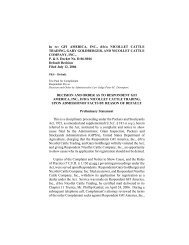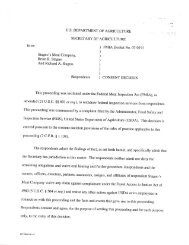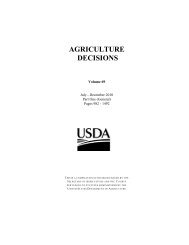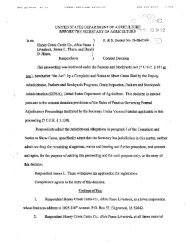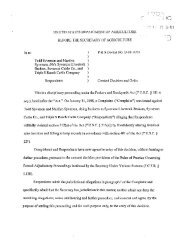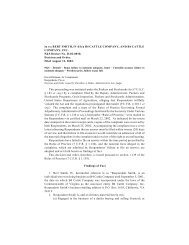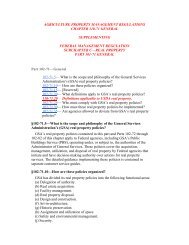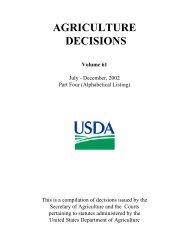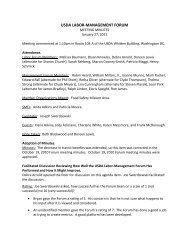1 UNITED STATES DEPARTMENT OF AGRICULTURE BEFORE ...
1 UNITED STATES DEPARTMENT OF AGRICULTURE BEFORE ...
1 UNITED STATES DEPARTMENT OF AGRICULTURE BEFORE ...
Create successful ePaper yourself
Turn your PDF publications into a flip-book with our unique Google optimized e-Paper software.
<strong>UNITED</strong> <strong>STATES</strong> <strong>DEPARTMENT</strong> <strong>OF</strong> <strong>AGRICULTURE</strong><br />
<strong>BEFORE</strong> THE SECRETARY <strong>OF</strong> <strong>AGRICULTURE</strong><br />
In re: ) AWA Docket No. 03-0035<br />
)<br />
ZOOCATS, INC., a Texas corporation; )<br />
MARCUS COOK, also known as MARCUS )<br />
CLINE-HINES COOK, an individual; and )<br />
MELISSA COODY, also known as MISTY )<br />
COODY, an individual; jointly doing )<br />
business as ZOO DYNAMICS and )<br />
ZOOCATS ZOOLOGICAL SYSTEMS )<br />
)<br />
Respondents ) DECISION AND ORDER<br />
This is an administrative proceeding initiated by the Animal and Plant Health<br />
Inspection Service (“APHIS”), an agency of the United States Department of Agriculture<br />
(“USDA”), by a complaint filed on September 30, 2003 and amended on May 8, 2007.<br />
The amended complaint alleges that on various occasions during July 2002 through<br />
February 2007, the named respondents violated the Animal Welfare Act (7 U.S.C. §§<br />
2131-2159; “the Act”) and regulations and standards under the Act (9 C.F.R. §§ 1.1-4.11;<br />
“the regulations and standards” or “the regulations”), by the methods they used to exhibit<br />
tigers and other animals to the public, and for failing to provide animals in their custody<br />
with proper care and treatment. Two respondents named in the amended complaint, Six<br />
Flags Over Texas, Inc. and Marian Buehler, agreed to the disposition of the allegations<br />
against them by a consent decree entered on February 5, 2007. In respect to the remaining<br />
respondents, APHIS seeks a finding that ZooCats does not meet the definition of a<br />
“research facility” as that term is used in the Act and the regulations; a cease and desist<br />
1
order; and the revocation of the exhibitor’s license it issued to ZooCats, Inc., or<br />
alternatively, the assessment of civil penalties of $100,000.00.<br />
APHIS is represented by its attorney, Colleen A. Carroll, Office of the General<br />
Counsel, USDA, Washington, DC. Respondents are represented by their attorney, Bryan<br />
L. Sample, Dallas, Texas. A transcribed hearing was held in this proceeding in Dallas,<br />
Texas, on January 28 through February 1, 2008, at which various documents were<br />
received in evidence and testimony subject to cross-examination was given. References<br />
to the transcript shall be indicated by the prefix “Tr.” followed by the page number.<br />
Exhibits are marked numerically with the prefix “Cx” for those sponsored by<br />
Complainant, and with the prefix “Rx” for those sponsored by Respondents. Post hearing<br />
briefs and proposed findings of facts, conclusions and written arguments were filed by<br />
both parties in accordance with a schedule set at the close of the hearing that was later<br />
extended at the request of the parties, and that ended on August 29, 2008.<br />
After fully considering the record evidence, the arguments of the parties and<br />
applicable law, I am entering an order that, for the reasons hereinafter stated, finds that<br />
ZooCats does not meet the definition of a “research facility” as that term is used in the<br />
Act and the regulations; subjects Respondents to a cease and desist order that prohibits<br />
the continuation of practices that have allowed members of the public, and children in<br />
particular, to be in dangerous, physical contact with lions, tigers and other predatory<br />
animals in violation of the Act and the regulations and standards; and revokes exhibitor<br />
license number 74-C-0426 issued to ZooCats, Inc.<br />
2
Findings<br />
1. Respondents Marcus Cline-Hines Cook, Janice Cook and Melissa<br />
(“Misty”) Coody are the directors of ZooCats, Inc., a Texas non-profit corporation that<br />
does business as ZooCats, Zoo Dynamics and ZooCats Zoological Systems. The<br />
corporation’s registered agent for service of process is Bryan L. Sample, 25 Highland<br />
Park Village, Suite 100, Dallas, Texas 75205-2726. At all relevant times, ZooCats, Inc.<br />
operated as an exhibitor as that term is defined in the Act (7 U.S.C. § 2132(h)) and the<br />
regulations (7 C.F.R. §1.1), and held a Class “C” Animal Welfare Act exhibitor license<br />
(number 74-C-0426) that is required by the regulations for all persons showing or<br />
displaying animals to the public.<br />
2. Respondents have a moderately-large business exhibiting wild and exotic<br />
animals for profit notwithstanding the registration of ZooCats as a Texas non-profit<br />
corporation.<br />
3. ZooCats, Inc. was also registered as a research facility, and held<br />
registration number 74-R-0172. However, from approximately April 15, 2004 to the date<br />
the amended complaint was filed, ZooCats was not a school, institution, or organization<br />
that uses or intends to use live animals in research, tests, or experiments; did not purchase<br />
or transport live animals for such purposes; and did not receive funds under a grant,<br />
award, loan, or contract from a department, agency, or instrumentality of the United<br />
States for the purpose of carrying out research, tests, or experiments.<br />
4. In addition to being a corporate director of ZooCats, Inc., Marcus Cline-<br />
Hines Cook, at all relevant times, was the operations director of ZooCats, Inc, and was<br />
the primary person involved in its day-to-day operations.<br />
3
5. Janice Cook is Marcus Cook’s mother and did not directly participate in<br />
the exhibition of animals by her son or ZooCats, Inc.<br />
6. Melissa (Misty) Coody is a police officer with whom Marcus Cook<br />
testified he has a romantic relationship, and who has “… contributed quite a bit of<br />
money, a loan, quite a bit of money as I did as well to ZooCats to help it get on its feet.”<br />
He further testified that in addition to being one of the top three directors of ZooCats,<br />
Inc., she has a long history of working with the big cats after being trained by him. (Tr.<br />
1280-1282).<br />
7. On May 23, 2002, Marcus Cook exhibited a tiger at a photographer’s<br />
studios without a physical barrier separating the tiger from the photographer. While the<br />
tiger was being posed and photographed, Mr. Cook and other trainers employed cattle<br />
prods to control it. It is uncertain whether the cattle prods were ever activated, or actually<br />
used to stun the tiger during the photo shoot.<br />
8. Respondents exhibited tigers and other animals, from June 8 to July 19,<br />
2002, at Six Flags, Arlington, Texas where children were allowed to handle and pose<br />
with tiger cubs, and have their pictures taken with them for a fee. On June 22, 2002,<br />
many children were observed being photographed while holding tiger cubs as they bottlefed<br />
them milk. The children were following instructions from teenage handlers employed<br />
by Respondents, and the purpose of the bottle-feeding was to distract the tiger cubs and<br />
keep them calm. The technique was risky at best and some people, including a child,<br />
were scratched by tiger cubs during these exhibitions. (Cx 19).<br />
9. On approximately 64 occasions between February 10 and February 14,<br />
2003, Respondents posed a small tiger with groups of children for class photographs that<br />
4
included kindergarten and first grade classes, at Prestonwood Christian Academy, 6801<br />
West Park Boulevard, Plano, Texas. During these photo shoots, children including<br />
kindergarteners, were allowed to touch the tiger which was being held by a handler who<br />
was bottle-feeding it. (Cx 24).<br />
10. On February 21, 2003, Respondents exhibited adult tigers at the Westin<br />
Galleria Hotel, Dallas, Texas, and photographed spectators for a fee while they fed a tiger<br />
raw meat that they pressed through the upper, metal bars of its cage to induce the tiger to<br />
stand on its hind legs and take the meat from their hands. (Cx 24).<br />
11. On November 4, 2003, a juvenile, 16 to 20 week old, male lion cub,<br />
owned by Respondents, was observed by an APHIS Veterinary Medical Officer, being<br />
exhibited in the retail area of a pet store at Animal Jungle, 4218 Holland Road, Virginia<br />
Beach, Virginia. The lion was in a room with a large viewing window on two sides from<br />
which it was periodically taken out on a leash by a handler who would distract it with a<br />
toy while spectators petted it. Numerous children surrounded the lion without any kind of<br />
crowd control or any physical barriers to prevent them from coming in contact with the<br />
lion. (Cx 27).<br />
12. On June 20 through June 27, 2004, Respondents exhibited two tigers at the<br />
Red River Valley Fair in Fargo, North Dakota and photographed spectators for a fee<br />
while they fed one of the tigers raw meat on a stick that they pressed through the metal<br />
bars of the tiger’s cage to induce it to stand on its hind legs and eat the meat off the stick.<br />
The evidence received at the hearing includes a photograph of a young boy standing next<br />
to Marcus Cook as the boy pressed raw meat on a stick into the open mouth of a caged<br />
tiger. (Cx 28, page 3).<br />
5
13. On February 12, 2005, Respondents exhibited a 15 week old tiger cub at<br />
the Tampa Bay Auto Mall, 3925 Tampa Road, Oldsmar, Florida where it was<br />
photographed with spectators. There were no barriers between the tiger and the spectators<br />
and the only control in place was that the tiger cub was on a leash held by a handler. A<br />
spectator tried to pet the tiger cub’s head and it nipped her with its teeth. The Florida Fish<br />
and Wildlife officer who investigated the incident would have had the tiger tested for<br />
rabies if the spectator who had been bitten had not signed a waiver. (Cx 35, page 15).<br />
14. On various occasions during the period of December 5, 2000 through<br />
February 23, 2007, APHIS inspected facilities where Respondents exhibited or housed<br />
animals they exhibited, and found instances of noncompliance with the regulations and<br />
standards. Many noncompliant items concerned inadequate records or minor infractions<br />
that Respondents remedied and were no longer found upon return visits by APHIS.<br />
However, the following were serious forms of noncompliance:<br />
a) On June 22, 2002, July 5, 2002, February 10 through February 14, 2003,<br />
February 21, 2003, November 4, 2003, June 20 through June 27, 2004 and June 20<br />
through June 27, 2004, contrary to 7 C.F.R. §2.131, tigers were being handled and<br />
exhibited in a manner that caused them trauma and behavioral stress with excessive risk<br />
of harm to the tigers and the public due to the lack of barriers and sufficient distance<br />
between the tigers and the viewing public, and without the presence, control and<br />
supervision of a knowledgeable and experienced animal trainer. In addition, on July 5,<br />
2002, contrary to 7 C.F.R. §3.131 and §3.132, sanitation and employee standards were<br />
not being followed in that cages containing prairie dogs and a bear were unclean with<br />
excessive fecal material and urine, and there was only one, unsupervised employee<br />
6
untrained in animal husbandry practices, caring for 3 wolves, 2 cougars, a bear and a<br />
tiger. (Cx 19).<br />
b) On June 12, 2003, contrary to housing standards set forth in 7 C.F.R.<br />
§3.127, tigers were being housed outdoors at the Respondents’Kaufman, Texas facility in<br />
primary enclosures that were not adequately drained. There were pools of water in the<br />
enclosures and five tigers were observed to be soiled, wet and standing in mud. On<br />
February 9, 2006, some tigers were still being housed in enclosures with clay surfaces to<br />
which some large rocks had been added for better drainage, but though it had not rained<br />
for a week, all but one of those tigers had dried mud caked to their hair on their legs and<br />
abdomens. One tiger had chewed off its hair to rid itself of the caked mud. On February<br />
23, 2007, the enclosure housing a lion and two tigers still had visible signs of drainage<br />
problems. (Cx 25, Cx 36 and Cx 38).<br />
c) On July 30, 2004, contrary to feeding standards set forth in 7 C.F.R. §<br />
3.129, Respondents were feeding animals every other day rather than daily, and the<br />
appearance of a number of young tigers indicated that their diet was insufficient and<br />
required evaluation by a veterinarian. On August 30, 2004, APHIS determined that<br />
though Respondents were now feeding the animals daily, a veterinarian had still not been<br />
contacted to evaluate the diet plan and the amount of food each animal needed and its<br />
need to be fed supplements. At an inspection of the Kaufman facility on October 22,<br />
2004, the dietary plan for the animals appeared insufficient to the APHIS inspector who<br />
ascertained that a plan of approved diet for the animals had still not been developed by an<br />
attending veterinarian even though Respondents were previously instructed that it was<br />
required. On February 9, 2006, a veterinarian employed by APHIS, with expertise in the<br />
7
care and feeding of lions, tigers and other big cats, accompanied an inspector and visited<br />
the Kaufman facility where she found tiger cubs with misshapen rear legs indicative of<br />
metabolic bone disease caused by a poor diet having been fed either to them or the cubs’<br />
mother. On the basis of the types of food found at the facility and admissions by Mr.<br />
Cook and an attendant at the facility, the veterinarian concluded that Respondents were<br />
not following the prescribed dietary recommendations of the attending veterinarian they<br />
employed. (Cx 29, p1, Cx 30, p 2, Cx 31, p 2, Cx 36 pp 1-9, Tr 84-126).<br />
d) On June 12, 2003, contrary to veterinarian care standards set forth in 7<br />
C.F.R. § 2.40, two tiger cubs suffering from alopecia (hair loss) were not being treated<br />
for this condition and were not taken to the attending veterinarian for diagnosis and<br />
treatment; instead, Marcus Cook was erroneously treating them with a medication for<br />
ringworm based on his own incorrect, uninformed diagnosis. On August 27, 2004, an<br />
APHIS inspector determined that a veterinarian had last visited Respondents’ Kaufman<br />
facility on June 30, 2003, contrary to this standard’s requirement for annual veterinarian<br />
visits. Moreover, at the time of the August 27, 2004 inspection, two of the youngest tigers<br />
and the smallest lion displayed protruding hip bones, dull coats of hair and less vigor than<br />
other animals at the facility. Respondents had not undertaken to have the cause of their<br />
condition evaluated by a veterinarian as instructed by APHIS inspectors at a prior<br />
inspection when these problems were first observed. On February 9, 2006 Respondents<br />
had not obtained veterinary care for a tiger that had re-injured a leg a couple of days<br />
earlier. (Rx 6, p 35). On February 23, 2007, a tiger requiring veterinarian evaluation due<br />
to its excessive hair loss and weight loss was observed by an APHIS inspector who<br />
8
determined from the records maintained by Respondents at the Kaufman facility, that the<br />
tiger had last been seen by a veterinarian on July 6, 2006. (Rx 6, p. 6).<br />
Conclusions<br />
1. The Secretary of Agriculture has jurisdiction under the Animal<br />
Welfare Act over Respondents who have acted as “exhibitors” of animals within the<br />
meaning of 7 U.S.C. § 2132(h). (Respondents’ brief).<br />
2. Respondent, ZooCats, Inc., presently registered as a research facility<br />
holding registration 74-R-0172, is not a research facility within the meaning of the<br />
Act (7 U.S.C. § 2132(e)) and the regulations (7 C.F.R. §1.1), in that it is not a school,<br />
institution, or organization that uses or intends to use live animals in research, tests,<br />
or experiments; does not purchase or transport live animals for such purposes; and<br />
does not receive funds under a grant, award, loan, or contract from a department,<br />
agency, or instrumentality of the United States for the purpose of carrying out<br />
research, tests, or experiments. (Finding 3, supra).<br />
3. Respondents violated the Act and the regulations and standards on<br />
the dates and by their acts and omissions set forth in findings 8-14, supra. The entry<br />
of a cease and desist order should be entered with both general and specific<br />
provisions to deter future violations. Specific provisions are needed to eliminate any<br />
assertion of confusion about the requirements of the regulations and standards that<br />
prohibit exhibitors such as Respondents from exhibiting dangerous animals in the<br />
absence of a knowledgeable, experienced, adult trainer, or without sufficient<br />
barriers and distance separating the animals from the public in order to prevent<br />
members of the public, particularly children, from holding, touching or otherwise<br />
being in dangerous contact with these animals.<br />
4. Exhibitor’s license number 74-C-0426 issued to ZooCats, Inc. should<br />
be revoked.<br />
Discussion<br />
In 1984, Marcus Cline-Hines Cook began his training as an animal handler when<br />
he was 19 years old. He worked for a company in South Texas, L&W Exotics, which was<br />
an exhibitor/breeder of lions, tigers, leopards, cougars, servals, bobcats and lynx. He<br />
continued working for the company on weekends through 1992 or 1993, and handled its<br />
animals at promotions for corporations conducting television photo shoots and<br />
conventions. In 1989, he purchased a black leopard that he still owns. In the early 1990’s,<br />
9
he became an animal control officer for the City of the Colony, a Dallas suburb, and held<br />
that position for several years. In 1993, he became a police officer for the City of Lake<br />
Dallas. He held that position until December 11, 1998 when his license as a peace officer<br />
was revoked by the Texas Commission on Law Enforcement Officer Standards and<br />
Education after a hearing which found that Mr. Cook had falsified his police officer<br />
application by representing himself to be a high school graduate when in fact he had not<br />
completed high school. As part of his application for the police officer position, he filed a<br />
fake high school diploma and a fake educational transcript. In 1994 or 1995, while still a<br />
police officer, he obtained a USDA license to exhibit animals and, with his parents,<br />
purchased property in Kaufman County for an animal facility. He then started to exhibit<br />
animals to school children and did photography shoots with film studios. He later became<br />
employed by the Dallas World Aquarium supervising divers who worked with marine<br />
animals. In the late 1990’s, while still employed by the Aquarium, Mr. Cook obtained a<br />
purported Bachelor of Zoology degree from “Wexford University”, a diploma mill, that<br />
issued the degree upon his payment of $1,800.00 without requiring, or giving him, any<br />
training or course instruction. He would later cite this degree as part of his qualifications<br />
as an expert witness when testifying in a case brought by APHIS against a colleague. (In<br />
re: Bridgeport Nature Center Inc., et al, AWA Docket No. 00-0032, transcript at 686).<br />
As an animal exhibitor, Mr. Cook has operated under various firm names. Before<br />
operating as ZooCats, he operated as Leopard One Zoological Center and published an<br />
“Operations Policy” that forbade any physical contact between animals and the public<br />
(Cx 11 at 8), and also stated:<br />
The Center does not approve of the use of exotic animals in off-site<br />
circumstances….it is our belief that naturalistic habitats are created for the<br />
10
educational benefit of exhibiting exotic animals to the public. When an animal is<br />
removed from that naturalistic habitat, that educational benefit is lost and cannot<br />
be replaced.<br />
(Cx 11 at 17-18).<br />
On June 18, 2001, he filed a complaint with APHIS against another animal<br />
exhibitor for photographing children for a fee with baby tigers. He made the complaint on<br />
the letterhead of the “American Association of Zoological Facilities”, which he signed as<br />
its President, stating:<br />
This organization was providing baby Tigers, on display, for a fee, and allowing<br />
small children to have there (sic) photo (sic) taken with these animals. As you<br />
know, this type of activity is a very dangerous one, as evidenced by past attacks<br />
and injuries to these small children placed in such close proximity to these cats.<br />
Once this was reported to us, we found several sections of violations and noncompliant<br />
issues we wish to report.<br />
Our main concerns were that these children were allowed so close to these cats,<br />
which had no control or restraint devices on them, (the cats), no physical barrier<br />
or trained barrier or trained personal (sic) between the animal and the child, and<br />
the children were allowed unrestricted access to the cat(s) while on the photo<br />
stage.<br />
(Cx 42 at 1). Attached to the complaint was the affidavit of the member of the<br />
Association who reported the event, Misty Coody. (Cx 42, at 3).<br />
In 2002, despite his protestations against exotic animals being exhibited at off-site<br />
locations with physical contact between the animals and children, Mr. Cook started doing<br />
just that. That year he accepted an arrangement with Six Flags Over Texas for ZooCats to<br />
exhibit animals at the Six Flags site from June 8 to July 19, 2002. As part of the animal<br />
exhibition, Mr. Cook employed teenage handlers who posed and photographed children<br />
holding tiger cubs that the children bottle-fed. One child is known to have been scratched<br />
by one of the cubs. In 2003, at the Prestonwood Christian Academy, he posed groups of<br />
children for class photographs with a small tiger that the children were allowed to touch<br />
11
while the only control over the tiger was a handler holding a bottle of milk. Also in 2003,<br />
for a fee he photographed spectators feeding his adult tigers by pressing raw meat into<br />
their cages. That year he also lent a male lion cub to a pet store in Virginia Beach,<br />
Virginia that anyone including children, could pet as it was walked about on a leash. In<br />
2004, again for a fee, he photographed spectators feeding raw meat through the bars of a<br />
cage to one of his tigers while it was standing on its hind legs. In 2005, he exhibited a 15<br />
week old tiger cub at an auto mall in Tampa, Florida where a spectator was nipped when<br />
she petted the animal while its handler walked it on a leash through the spectators.<br />
practices:<br />
The regulation governing the handling of animals specifically prohibits these<br />
(c)(1) During public exhibition, any animal must be handled so there is minimal<br />
risk of harm to the animal and to the public, with sufficient distance and/or<br />
barriers between the animal and the general viewing public so as to assure the<br />
safety of animals and the public.<br />
(d)(3) During public exhibition, dangerous animals such as lions, tigers, wolves,<br />
bears, or elephants must be under the direct control and supervision of a<br />
knowledgeable and experienced animal handler.<br />
7 C.F.R. § 2.131.<br />
The need to enforce these requirements even when the tiger is a cub rather than an<br />
adult animal was explained by Dr. James M. Jensen, a professor of veterinarian medicine<br />
and an expert zoologist:<br />
…I feel like the intensive handling of these animals, with teeth and claws, that are<br />
starting to develop their rough and tumble nature, in the wild they would be mock<br />
fighting with their siblings at this age, and developing their early hunting skills,<br />
as, you know, its going to mature over many months.<br />
But that kind of behavior, sitting next to a five-year old kindergartener is a little<br />
dangerous, particularly when the whole priming event here is a bottle feeding, and<br />
that’s when these youngsters become voracious, and aggressive, and get impatient<br />
when they’re sucking air out of the bottle.<br />
12
So, I, my thinking is that that should really should be stopped as soon as possible.<br />
Tr. 339-340.<br />
An affidavit by Dr. Jensen explains the risk of disease being transmitted by these<br />
animals to people, particularly children, who come in close contact with them:<br />
16. .…(D)isease transmission is an equally problematic issue. Large felines are<br />
significant carriers of salmonella bacteria species and intestinal roundworms.<br />
These organisms are found on the fur, the claws and in the feces of large felines,<br />
including juveniles.<br />
17. Large felines are latent carriers of Salmonella. In fact, they carry this bacterial<br />
pathogen in their intestines and without showing signs of illness. In susceptible<br />
large felids (i.e. young animals), stress may induce them to shed large amounts of<br />
this organism as they become ill. Humans are susceptible to Salmonella and often<br />
experience severe, and occasionally life-threatening enteritis. This organism poses<br />
its greatest threat to children. Strict sanitation of surroundings and disinfection<br />
must be maintained to avoid Salmonella infection. People should also wash their<br />
hands or use a hand antiseptic product after handling suspect animals. Large<br />
felines that are in contact with the public should have frequent fecal bacterial<br />
cultures or PCR (polymerase chain reaction) exams for Salmonella.<br />
18. Large felid species also have intestinal roundworms that are a threat to the<br />
public health. Toxocara cati and toxocaris leonina are capable of causing larval<br />
migration in humans. The infection larva can exist on a cat’s fur or in the<br />
environment. When the organism invades the humans body it migrates until the<br />
body “walls off” the parasite. Children are more susceptible to this parasite than<br />
adults. These two roundworms are difficult to eradicate from a contaminated<br />
environment because of their ability to shed large numbers of eggs and because of<br />
the hardness of their eggs….<br />
Cx 39 pp 4-5<br />
And just as there are numerous cases of humans being terrorized or injured by<br />
dangerous animals when there is insufficient distance and barriers between them, 1 there<br />
1 Complainant’s brief, p. 21, fn 60, lists some dozen cases of this type that include the following final<br />
decisions by the Secretary of Agriculture: In re Reginald Dwight Parr, 59 Agric. Dec. 601(2000) (tigers);<br />
In re Bobby F. Steele d/b/a Bob Steele Animal Promotions, 46 Agric. Dec. 563 (1987) (cougar); and In re<br />
William Joseph Vergis, 55 Agric. Dec. 148 (1996) (tiger).<br />
13
are cases demonstrating that the safety of the animals themselves that the Act was<br />
enacted to protect, is also endangered. 2<br />
In addition to the astonishing lack of precaution taken by Respondents to protect<br />
the public and the animals from harm, Respondents also often failed to feed their animals<br />
properly or provide them with veterinary and other requisite kinds of care.<br />
The entry of a cease and desist order by itself would probably not deter future<br />
violations by Respondents. Nor, in my opinion, would the imposition of civil penalties,<br />
even in combination with a cease and desist order, be sufficient. I have concluded that the<br />
revocation of the exhibitor’s license that Respondents hold in the name of ZooCats, Inc.,<br />
together with the entry of a cease and desist order with both general and specific<br />
provisions, as authorized by 7 U.S.C. §2149 (a) and (b), is required.<br />
Respondents have repeatedly endangered the lives of their customers and<br />
employees, as well as the lives of their animals. Marcus Cook has a history of deceiving<br />
the public, APHIS, and other law enforcement agencies. 3 He has represented himself to<br />
have expertise and credentials that he does not possess to mislead government<br />
authorities. 4<br />
To allow Marcus Cook or Melissa Coody to have an exhibitor’s license in<br />
either of their names, or through a corporation or other entity that either of them controls,<br />
would subject both the public and the animals Respondents would exhibit, to an<br />
2 The Complainants brief, p. 21, fn 61, lists cases where close contact with the public resulted in animals<br />
being treated violently and sometimes killed.<br />
3 The evidence in this proceeding shows instances of Respondents’ customers being scratched by their tiger<br />
cubs at the Six Flags exhibition in 2002, yet on February 15, 2005, Marcus Cook told a Florida law<br />
enforcement officer that “in his fifteen years of experience with adult and juvenile tigers this is the first<br />
time he has ever had a customer injured.” Cx 35 p 15.<br />
4 See Cx 1 and Cx 2.<br />
14
unacceptable level of risk of harm. The present license that they operate under is<br />
therefore being revoked.<br />
The issuance of a cease and desist order is also being entered containing, in<br />
addition to general provisions, specific provisions for the elimination of any future,<br />
professed confusion by Respondents, or other exhibitors, about the safeguards they must<br />
take under the regulations and standards when they exhibit dangerous animals to the<br />
public, and particularly to children. The requirement set forth in 7 C.F.R. § 2.131 (d)(3),<br />
that during public exhibition, dangerous animals such as lions and tigers must be under<br />
the direct control and supervision of a knowledgeable and experienced animal handler, is<br />
not met when the trainer is a teenager regardless of how much natural talent the teenager<br />
might appear to possess. So too, the regulation’s requirement (7 C.F.R. § 2.131 (c)(1))<br />
that there be sufficient distance and/or barriers between an animal and the public is not<br />
met when members of the public are allowed to hold or come close to a dangerous<br />
animal’s teeth and claws, or, in the case of children, are so close that they also become<br />
susceptible to the transmission of diseases or parasites..<br />
The following Order is therefore being issued.<br />
ORDER<br />
It is hereby ORDERED that ZooCats, Inc., Marcus Cook, also known as Marcus<br />
Cline-Hines Cook, and Melissa Coody, also known as Misty Coody, jointly doing<br />
business as Zoo Dynamics and ZooCats Zoological Systems, their agents, employees,<br />
successors and assigns, directly or through any corporate or other device, shall cease and<br />
desist from violating the Animal Welfare Act and the regulations and standards issued<br />
under the Animal Welfare Act.<br />
15
It is specifically ORDERED that the above-named respondents shall cease and<br />
desist from publicly exhibiting lions and tigers or other dangerous animals that are not<br />
under the direct control and supervision of a knowledgeable, experienced handler who<br />
must be at least twenty-one years of age.<br />
It is also specifically ORDERED that the above-named respondents shall cease<br />
and desist from publicly exhibiting any lion or tiger, including a cub or a juvenile, unless<br />
the animal is contained inside a suitable primary enclosure with any needed secondary<br />
barrier such as a perimeter fence sufficiently distanced from the primary enclosure in<br />
conformity with the requirements of 7 C.F.R. § 3.127(d) that may be varied only when<br />
appropriate alternative security measures are approved in writing by the Administrator of<br />
APHIS, so as to completely preclude any member of the public from touching or coming<br />
in contact with any part of the animal. To fully effectuate this provision, special attention<br />
shall be given to the safety of children to eliminate any contact between them and the<br />
animals, their teeth, claws, fur or feces.<br />
It is further ORDERED that Animal Welfare Act license number 74-C-0426<br />
issued to ZooCats, Inc., is permanently revoked.<br />
This decision and order shall become effective and final 35 days from its service<br />
upon the parties who shall have the right to file an appeal with the Judicial Officer within<br />
30 days after receiving service of this decision and order by the Hearing Clerk as<br />
provided in the Rules of Practice (7 C.F.R. § 1.145).<br />
Dated: September 24, 2008<br />
___Victor W. Palmer___________<br />
Victor W. Palmer<br />
Administrative Law Judge<br />
16




